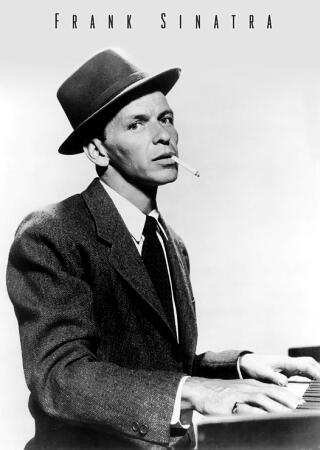In Celebration of the Human Voice - The Essential Musical Instrument
Home | Doo Wop | Barbershop | World | Contemporary | Christian | Vocal Jazz | Choral | Christmas | Instructional | Arrangements
Classical | Opera | Musicals | Personality | Young Singers | Disney | Videos | Songs | The Artists

Frank Sinatra Biography

Click Here for Sheet Music and Songbook Vocal Arrangements
Frank Sinatra, American singer and motion-picture actor who, through a long career and a very public personal life, became one of the most sought-after performers in the entertainment industry; he is often hailed as the greatest American singer of 20th-century popular music. Sinatra's father, Martin, was a tavern owner and part-time prizefighter, and his mother, Natalie-known to all as "Dolly"-was a domineering influence in both local politics and in her son's life and career. Upon hearing the recordings of Bing Crosby, Sinatra was inspired as a teenager to choose popular singing as a vocation. He joined a local singing group, which, as the Hoboken Four, won a talent competition in 1935 on the popular radio program Major Bowes' Amateur Hour. The group toured the country that year, but Sinatra was the only member with serious musical ambitions, and they soon disbanded. For the next few years, Sinatra sang with local dance bands and for remote radio broadcasts. In 1939, while singing and waiting tables at the Rustic Cabin in Englewood Cliffs, New Jersey, he was discovered and hired by trumpeter Harry James, who had recently quit the Benny Goodman Orchestra to start his own band. Sinatra's six-month tenure with the James band resulted in 10 commercial recordings featuring the young singer. On songs such as "From the Bottom of My Heart,""My Buddy," and "Ciribiribin," Sinatra's warm baritone and sensitivity to lyrics are well showcased. The best-known of the James-Sinatra sides is "All or Nothing at All"-a flop in 1939 but a million-seller when rereleased in 1943, after both men had become stars. Sinatra's reputation among industry musicians grew swiftly, and James graciously freed Sinatra from his contract when the singer received a more lucrative offer from bandleader Tommy Dorsey in December 1939. The 83 commercial recordings (as well as several surviving air checks) that Sinatra went on to make with the Dorsey band from 1940 to 1942 represent his first major body of work. Sinatra was enormously influenced by Dorsey's trombone playing and strove to improve his breath control in order to emulate Dorsey's seamless, unbroken melodic passages. It was also during this period that Sinatra proved his mastery of both ballads and up-tempo numbers, and Dorsey arrangers Axel Stordahl, Paul Weston, and Sy Oliver soon tailored their arrangements to highlight Sinatra's skills. Often teamed with singer Connie Haines, or with Dorsey's vocal group, The Pied Pipers (featuring future recording star Jo Stafford), Sinatra was featured on memorable sides such as "I'll Never Smile Again," "I'll Be Seeing You," "Without a Song," and "Oh! Look at Me Now." Awards
Frank Sinatra VideosWe Wish You the MerriestDeck your hall with this swinging Christmas song that's positively brimming with Yuletide cheer. Popularized by Frank Sinatra in the 1960s with Bing Crosby, it has remained a holiday standard through the generations! We Wish You the MerriestDeck your hall with this swinging Christmas song that's positively brimming with Yuletide cheer. Popularized by Frank Sinatra in the 1960s with Bing Crosby, it has remained a holiday standard through the generations! We Wish You the MerriestDeck your hall with this swinging Christmas song that's positively brimming with Yuletide cheer. Popularized by Frank Sinatra in the 1960s with Bing Crosby, it has remained a holiday standard through the generations! My One and Only LoveBeautiful a cappella textures shape this classic Sinatra ballad into a fantastic vocal jazz showpiece! From full homophonic harmonies to solo lines with vocal accompaniment, this setting is a compelling spectrum of sound. |
Select a Category |
Want to Sing? - Find a Chorus Near You
List of Choruses by State | List of Choruses by City




